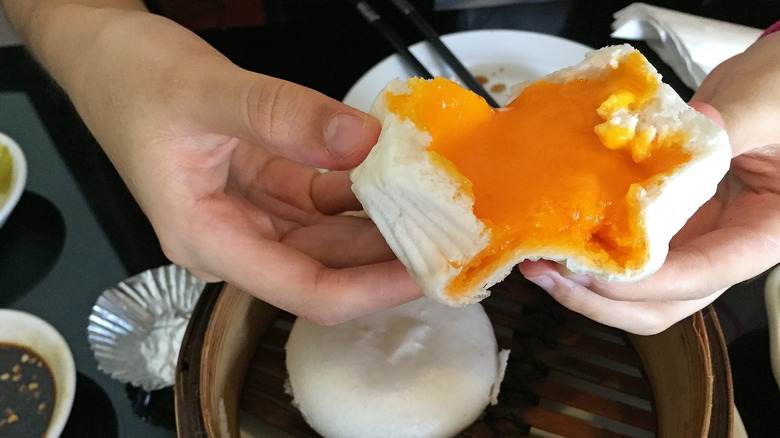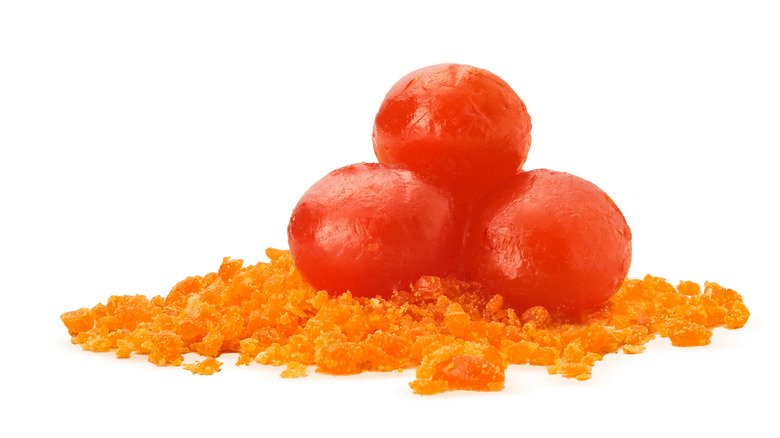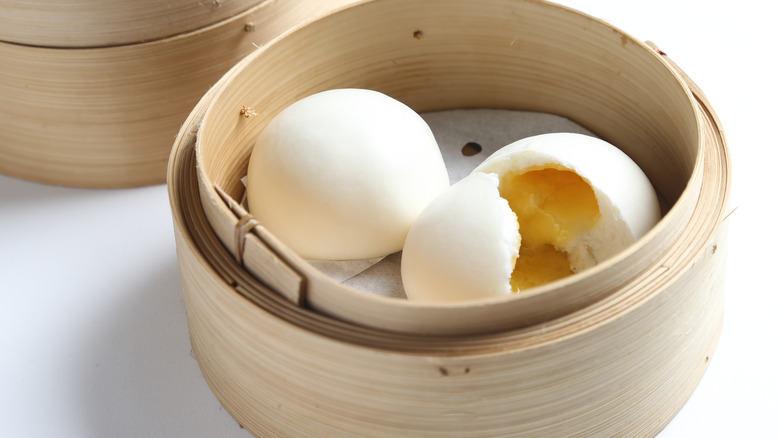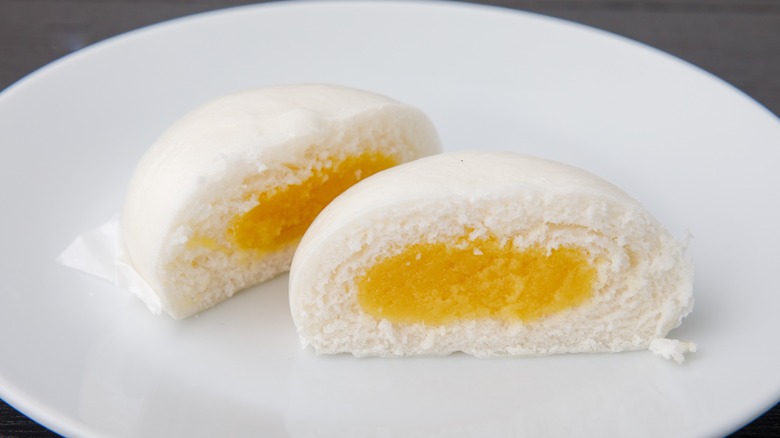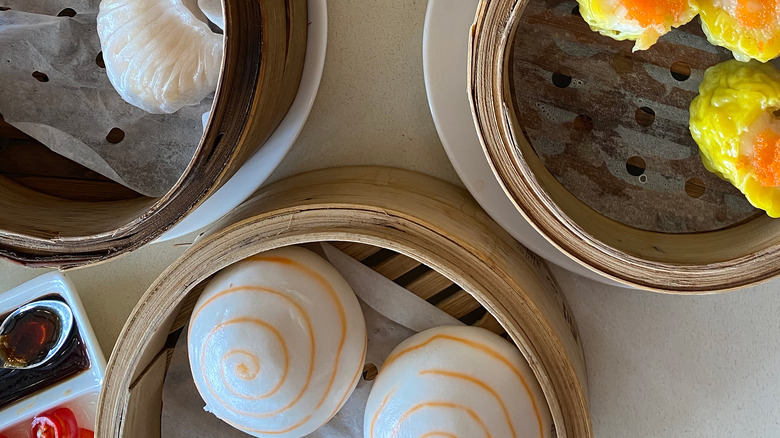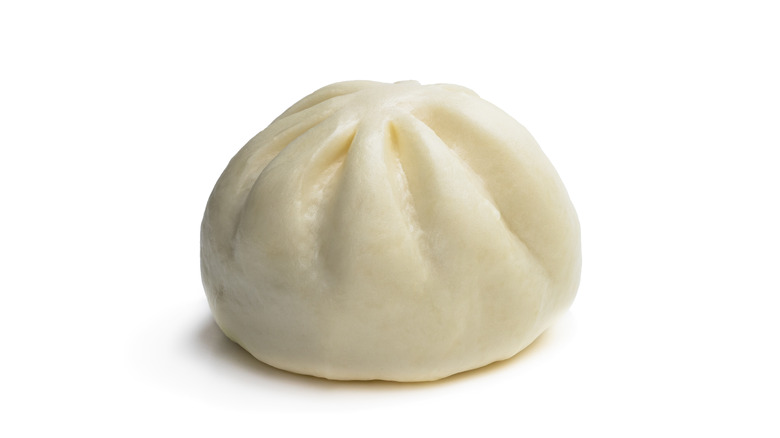Liu Sha Bao: The Savory Chinese Buns With A Yolky Center
Any dim sum connoisseur will know that the push cart parade of goodies doesn't stop at savory treats like siu mai or chicken feet, and that there are many decadent and unique desserts worth saving some space for. Even though dim sum is derived from a Cantonese word that means appetizer paired with tea, sweet endings like the liu sha bao are also often available at dim sum establishments.
Liu sha bao is the sweet equivalent of the char siu bao; it's a steamed and soft white bun, but instead of a barbecue pork filling, there is a hot golden custard filling that is sugared with just a slight touch of salty savory flavor. While it's a staple of the Cantonese dim sum menus today, the liu sha bao is a recent addition to the cuisine which dates back to over 2,500 years ago. Here is everything you need to know about liu sha bao.
What liu sha bao is made out of and what it tastes like
Liu sha bao is known as a flowing sand bun because once you tear open the fluffy white bao exterior, a molten golden lava made up of salted egg yolks (usually salted duck eggs are used), butter, sugar, milk powder, and custard or custard powder. The fluffy bao exterior is made up of even more ingredients: whole fat milk, instant or dry active yeast, granulated sugar, flour, wheat starch (which is what makes the dough super soft), powdered sugar, baking powder, salt, vegetable shortening, egg white, vegetable oil, lemon juice, and baking ammonium bicarbonate.
The taste of a liu sha bao is a unique savory and sweet combination, as a result of the contrast of the savory salted duck egg and the added sugar, delivered in a creamy and hot filling enveloped in a fluffy bun. Some people think that the savory salted duck egg flavor even tastes a bit like cheese.
The history of liu sha bao
Fluffy, soft, and white steamed buns with filling, also known as baos, have a long history in China: some date the buns back to the third century, while other historians believe baos have been referenced in writing as early as 400 BC. However, the liu sha bao, which translates literally to "flowing sand buns", only started to pop up in Hong Kong in 2009. Also known as salted egg yolk buns or salted egg custard buns, liu sha bao also is sometimes called a Phoenix bun.
While it's unclear who was the original inventor of liu sha bao, some claim that Tam Shek-wing, of Hong Kong, first concocted a recipe for a custard bun that called for milk and salted egg yolk, which then led to a frenzy among professional Guangdong kitchens to create their own versions of the sweet treat. Soon after liu sha bao gained popularity in Hong Kong, the buns made their way to Singapore in 2011, sparking a salted duck egg taste craze.
The difference between liu sha bao and nai wong bao
Custard buns are fairly popular in Chinese cuisine, and sometimes liu sha bao will be translated simply as such. However, there are two common types of custard buns, and the other variety is called nai wang bao, which is also found on many dessert dim sum carts. However, unlike liu sha bao, nai wang bao is slightly sweeter because while its filling contains custard powder and egg yolk, the egg yolks are not salted. Nai wang bao is a creamier custard, where the filling isn't as granular or runny.
These custard buns were the predecessor to the liu sha bao, which elevated the custard bun with a savory salted duck egg, first done by a restaurant in the Peninsula Hotel in Hong in 1986. Soon liu sha bao, which is runnier and more savory than the original nai wang bao, began to take over dim sum menus, rendering the creamier custard bun harder to find. Given their Instagram aesthetic appeal, that has only helped their dominance, too.
Nutritional profile of liu sha bao and how it's eaten
Liu sha bao is slightly less sugary than a normal custard bun, and a single salted egg custard bun has around 168 calories, 5.4 grams of fat, and 4.2 grams of sugar. The salted duck egg filling is also chock full of vitamins and minerals, such as vitamin A, B12, selenium — which helps support immune function — and iron, though it also has a high amount of cholesterol.
Typically, liu sha bao is eaten for breakfast, as a snack, or of course, at the end of a dim sum meal for a savory-sweet finish. Liu sha bao is also typically eaten with the hands, though beware that due to the molten lava-esque nature of the filling, it can be messy. One technique to not waste any of the irresistible filling is to soak up any that's dripped onto the plate with a piece of the fluffy bun exterior.
Where to eat and how to make liu sha bao
Most dim sum establishments worth their salt(ed duck egg) will have liu sha bao on the menu, and due to the popularity of the distinctive, intense savory and sweet flavor, salted-duck-egg-flavored everything, including potato chips, has become a bona fide TiKTok trend.
Popular dim sum restaurant chain Din Tai Fung also offers the salted egg custard buns seasonally, along with other flavors like chocolate. Some restaurants even offer unique spins on the liu sha bao, such as Los Angeles restaurant Needle, which has a French toast inspired by the Hong Kong treat. If you want to make your own liu sha bao at home, it's possible to make everything – bun and filling – from scratch; you just need flour, milk, yeast, oil, salted duck eggs (though regular cooked egg yolks will work in a pinch, too), sugar, butter, custard powder, milk powder, and a steamer. These buns will store for 4 to 5 days in a refrigerator, or you can even make a large batch to freeze for later steaming for a quick, savory, breakfast. However, certain online shops also offer frozen egg yolk custard buns, which you can easily steam at home, saving you a lot of time.
